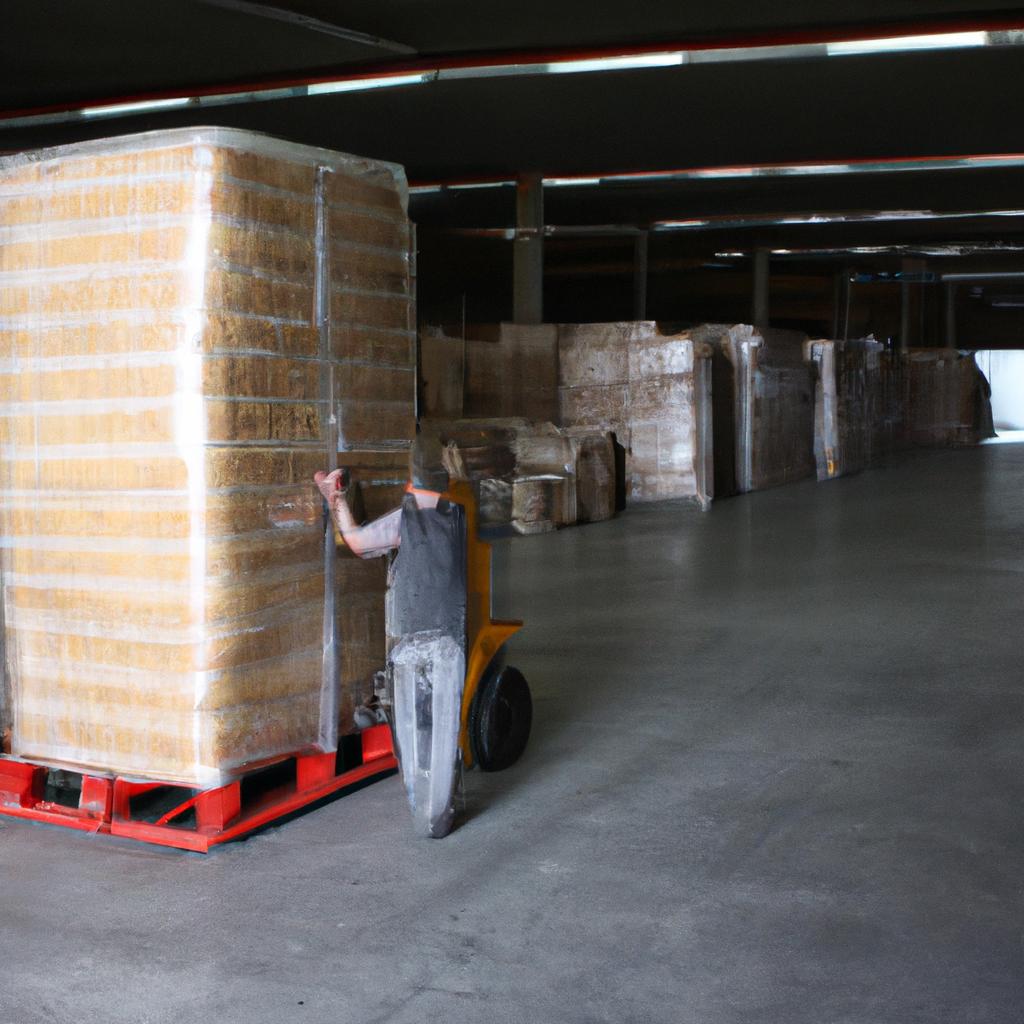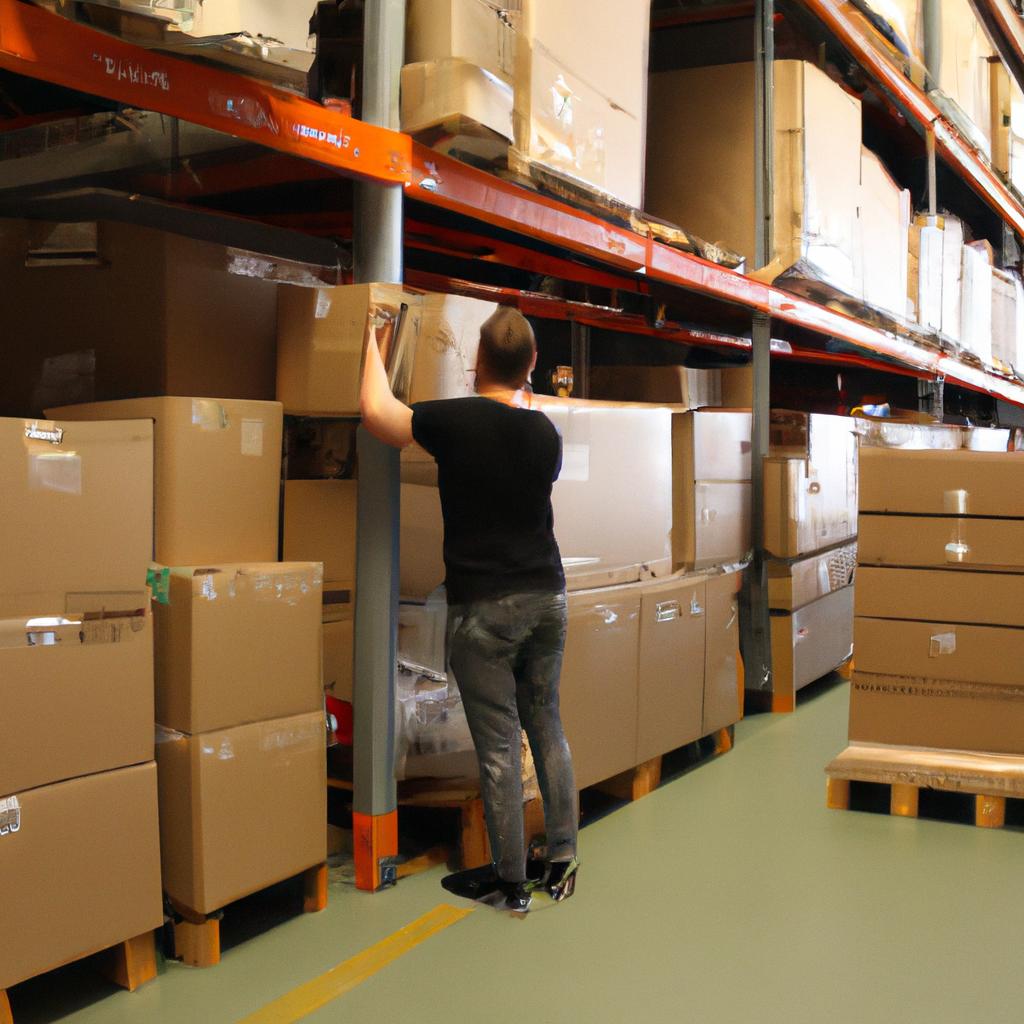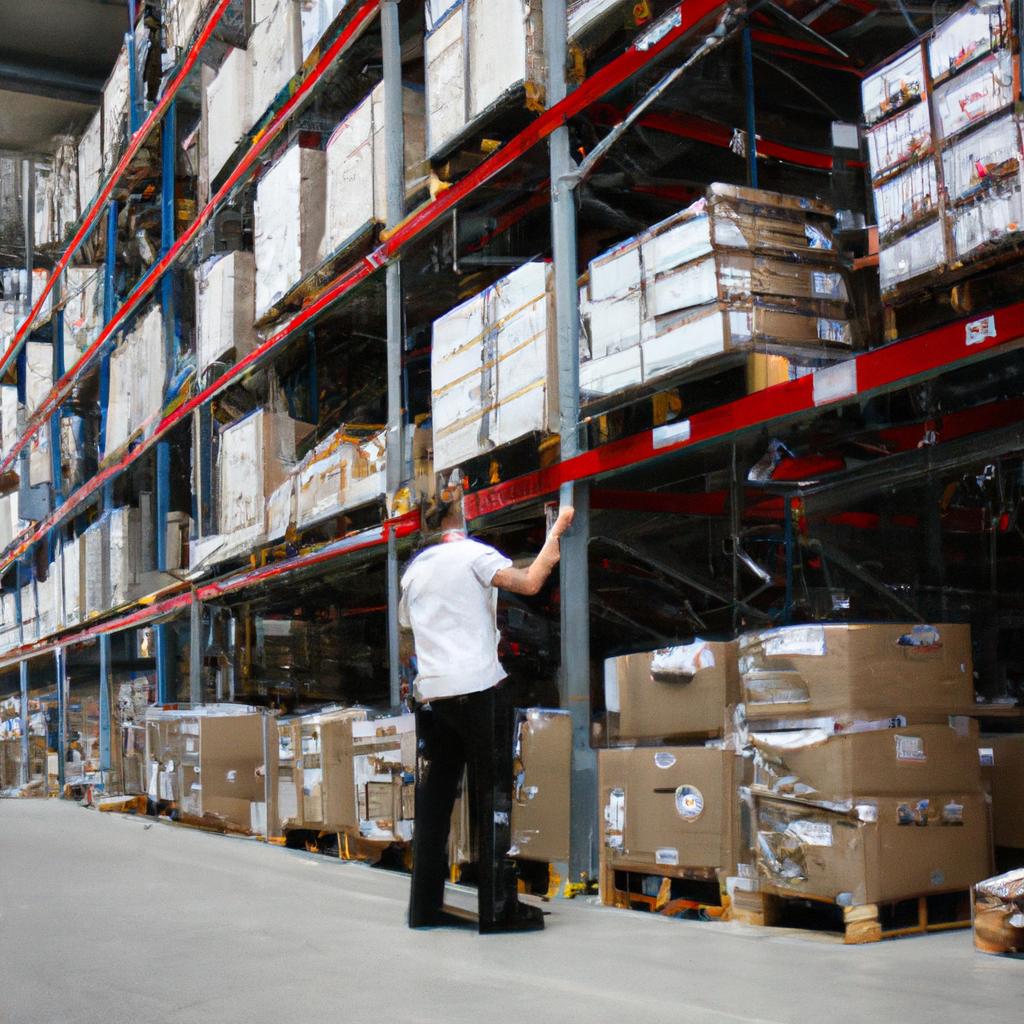The transportation and logistics industry plays a crucial role in the global economy, facilitating the movement of goods across borders. International freight forwarding is a key component of this industry, serving as an intermediary between exporters and importers to ensure smooth and efficient transportation of goods. To illustrate the significance of international freight forwarding, let us consider the case study of a multinational corporation based in Germany that exports automotive parts to various countries around the world.
In this scenario, the German company relies heavily on its partnership with a freight forwarder to navigate complex logistical challenges involved in transporting their products overseas. The freight forwarder takes charge of coordinating multiple modes of transportation, such as trucks, ships, and planes, to deliver the automotive parts from the manufacturing facility in Germany to destinations scattered across different continents. They also handle all necessary documentation requirements for customs clearance at each port or airport along the journey. Without the expertise and guidance provided by the freight forwarder, delays and inefficiencies could arise, potentially leading to financial losses for both parties involved.
International freight forwarding encompasses a wide range of activities beyond mere transportation coordination. It involves strategic planning, risk management, supply chain optimization, and compliance with regulatory frameworks governing cross-border trade. This article aims to explore these aspects further within the context of international trade and the role of freight forwarders.
One crucial aspect of international trade facilitated by freight forwarders is strategic planning. Freight forwarders work closely with exporters to determine the most efficient and cost-effective routes for transporting goods based on factors such as distance, transit times, and available modes of transportation. They consider variables like trade agreements, customs regulations, and potential disruptions in order to optimize logistics operations.
Risk management is another vital component of international freight forwarding. Freight forwarders help mitigate risks associated with shipping goods across borders by providing insurance options, ensuring compliance with security protocols, and handling necessary documentation accurately. They also monitor shipments throughout their journey to identify any potential issues or delays and take proactive measures to address them promptly.
Supply chain optimization is a key focus for freight forwarders. They collaborate with various stakeholders involved in the supply chain, including manufacturers, carriers, customs agents, and warehouses, to streamline processes and minimize costs. By coordinating activities efficiently and leveraging their expertise in logistics management, freight forwarders help ensure timely delivery of goods while optimizing inventory levels and reducing overall supply chain costs.
Compliance with regulatory frameworks governing cross-border trade is a critical responsibility of freight forwarders. They stay updated on ever-changing import/export regulations imposed by different countries and assist exporters in meeting all necessary requirements for customs clearance. This includes preparing accurate documentation such as commercial invoices, packing lists, certificates of origin, and ensuring adherence to import/export restrictions or quotas.
In summary, international freight forwarding plays a pivotal role in facilitating global trade by managing complex logistical challenges involved in transporting goods across borders. Freight forwarders provide strategic planning expertise, risk management solutions, supply chain optimization strategies, and ensure compliance with regulatory frameworks governing international trade. Their contributions are essential for businesses engaged in export-import activities to achieve smooth operations and maximize efficiency in the transportation of goods worldwide.
Understanding International Freight
Imagine a scenario where an electronics manufacturing company in Japan wants to ship its products to retailers in the United States. The process of transporting these goods from one country to another involves various complexities and challenges. This section aims to provide an overview of international freight, exploring its significance, key stakeholders involved, and the factors that influence decision-making in this field.
Significance of International Freight:
International freight refers to the transportation of goods across national borders through different modes such as air, sea, road, or rail. It plays a vital role in facilitating global trade by connecting manufacturers with consumers worldwide. For instance, consider a case study where a fashion retailer based in Italy relies on international freight services to import fabrics from India and export finished garments to markets across Europe. Without efficient logistics networks and reliable freight forwarding companies, such transactions would be challenging and costly.
Key Stakeholders:
Several stakeholders are involved in international freight operations. These include shippers (companies exporting or importing goods), carriers (transportation providers), freight forwarders (intermediaries coordinating shipments), customs authorities (government agencies regulating cross-border trade), and insurance providers (offering coverage for potential risks). Each stakeholder has distinct roles and responsibilities within the supply chain, ensuring smooth movement of goods from origin to destination.
Factors Influencing Decision-Making:
When it comes to international freight decisions, several factors come into play. Shippers need to consider aspects such as cost-effectiveness, reliability, speed of delivery, cargo volume, regulatory requirements, and environmental considerations. To illustrate this point further:
- Cost-effectiveness: Companies often seek affordable shipping options without compromising on quality.
- Reliability: Timely delivery is crucial for businesses; thus, selecting dependable carriers becomes essential.
- Regulatory Requirements: Compliance with customs procedures and documentation is necessary for smooth clearance at borders.
- Environmental Considerations: Increasingly, organizations prioritize sustainable practices when selecting transportation modes, seeking to reduce their carbon footprint.
Emotional Response:
Consider the following bullet point list and table that evoke an emotional response by highlighting the impact of international freight on businesses and economies:
- The global economy heavily relies on international freight for seamless trade.
- Efficient logistics networks enable timely delivery, satisfying customer demands and boosting business growth.
- Freight forwarding companies play a crucial role in facilitating smooth cross-border transactions.
- Compliance with customs regulations ensures adherence to legal requirements and fosters trust among trading partners.
| Benefits of International Freight | Challenges Faced | Solutions Provided |
|---|---|---|
| Facilitates global trade | Complex documentation | Expert guidance |
| Enhances market accessibility | Customs clearance delays | Streamlined processes |
| Supports economic development | Transportation risks | Insurance coverage |
| Promotes cultural exchange | Environmental concerns | Sustainable practices |
Understanding the significance and complexities of international freight sets the stage for exploring various modes of transportation involved in this intricate process. In the subsequent section, we will delve into these modes, analyzing their advantages, disadvantages, and suitability across different types of cargo.
Modes of International Transportation
In the previous section, we explored the intricacies of international freight and its significance in today’s globalized world. Now, let us delve deeper into the various modes of transportation that are commonly employed for moving goods across borders.
Imagine a scenario where a company in Germany needs to transport a shipment of automotive parts to Mexico. To accomplish this task efficiently, they have several options at their disposal. One possible mode of transportation is air freight, which offers speed and reliability. By utilizing dedicated cargo planes, the company can ensure timely delivery while minimizing transit time. Additionally, air freight provides an advantage when it comes to perishable or high-value goods.
However, air freight may not always be the most cost-effective option. In our hypothetical case study, if the German company seeks a more economical solution without compromising delivery timelines significantly, ocean freight becomes appealing. With access to container ships capable of carrying large volumes of cargo, the company can benefit from economies of scale and lower shipping costs per unit. Although ocean freight might take longer than air transport, careful planning could still result in efficient logistics management.
Another alternative worth considering is rail freight. While traditionally popular within certain regions like Europe and Asia, rail transportation is gaining traction globally due to its environmental friendliness and ability to carry heavy loads over long distances swiftly. In our example, using rail freight from Germany to Mexico would involve coordinating with multiple railway operators along different routes but could offer significant advantages in terms of reduced carbon emissions and potentially shorter transit times compared to solely utilizing ocean shipping.
To further illustrate these points effectively and evoke an emotional response from readers contemplating international freight choices for their own businesses or personal interests:
- Air Freight: Fast and reliable; ideal for urgent shipments such as medical supplies during emergencies.
- Ocean Freight: Economical option for transporting bulk goods; enables affordable trade between countries with varying economic capabilities.
- Rail Freight: Environmentally friendly choice; promotes sustainable logistics practices while offering efficient connectivity between regions.
- Intermodal Transportation: Seamlessly combines multiple modes of transportation, maximizing efficiency and reducing costs.
Table: Advantages of Different Freight Modes
| Air Freight | Ocean Freight | Rail Freight | |
|---|---|---|---|
| Speed | Fast | Slow | Moderate |
| Cost | High | Low | Moderate |
| Volume | Limited | Large | Medium to large |
| Emissions | Higher | Lower | Lower than road or air |
As we can see from our case study example and the emotional impact conveyed through the bullet point list and table, choosing the most suitable mode of transportation for international freight involves weighing several factors. Each option has its unique advantages depending on specific requirements such as time sensitivity, cost-efficiency, environmental considerations, and volume of goods.
In the subsequent section about “Key Players in International Freight,” we will explore the various entities involved in facilitating seamless logistics operations across borders. By understanding their roles and interactions within this complex ecosystem, stakeholders can make informed decisions to optimize their international freight processes.
Key Players in International Freight
International freight transportation encompasses a variety of modes that are crucial for the efficient movement of goods across borders. Each mode offers distinct advantages and caters to different types of cargo, distances, and time constraints. Understanding these modes can greatly assist in making informed decisions when it comes to selecting the most suitable method for transporting goods internationally.
For instance, let’s consider an example where a manufacturing company based in China wants to export its products to Europe. The company has two options: air freight or ocean freight. Air freight is known for its speed and reliability, making it ideal for perishable goods or urgent shipments. On the other hand, ocean freight is more cost-effective and suitable for larger volumes of less time-sensitive cargo.
When considering international transportation methods, there are several factors to take into account:
- Cost: Different modes have varying costs associated with them. While air freight may be expensive compared to other modes, it provides faster delivery times, reducing overall inventory costs.
- Transit Time: Depending on the urgency of the shipment, transit time becomes a critical factor in selecting a transportation mode.
- Infrastructure: Availability and accessibility of infrastructure play a significant role in determining which transport mode is feasible in specific regions.
- Environmental Impact: Concerns about carbon emissions and sustainability have led companies to evaluate the environmental impact of their transportation choices.
To illustrate further, refer to the table below showcasing a comparison between air freight and ocean freight:
| Factors | Air Freight | Ocean Freight |
|---|---|---|
| Speed | Fast | Slow |
| Cost | Expensive | Cost-effective |
| Capacity | Limited | Large |
| Emissions | High | Lower |
As seen from this comparison, each mode presents unique characteristics that must align with the specific needs of businesses engaged in international trade.
In light of understanding various modes of international transportation, it becomes apparent that choosing the right mode is crucial for successful freight forwarding operations. The subsequent section will delve into another essential aspect of international freight: the role of customs in ensuring smooth and compliant movement of goods across borders.
The Role of Customs in International Freight
To ensure the smooth flow of goods across borders, customs plays a vital role in international freight. By enforcing regulations and facilitating trade, customs agencies contribute to the overall efficiency and security of global supply chains. This section will examine the key functions performed by customs in international freight, using real-life examples to illustrate their impact.
Customs Functions:
One example that highlights the importance of customs in international freight is the case of Company X, an exporter seeking to ship its products from Country A to Country B. Upon reaching its destination port, Company X’s shipment was held by customs due to incomplete documentation. As a consequence, delays occurred, resulting in additional costs for both Company X and its customer. This scenario emphasizes the crucial role played by customs authorities in ensuring compliance with legal requirements and preventing disruptions in cross-border transportation.
In order to better understand the multifaceted nature of customs’ involvement in international freight, let us explore four key functions they perform:
- Documentation control: Customs verifies all necessary paperwork accompanying each shipment, such as commercial invoices, packing lists, and certificates of origin.
- Tariff classification: Determining the correct tariff code for imported or exported goods enables proper assessment of duties and taxes.
- Risk management: Customs assesses potential risks associated with shipments, conducting inspections when deemed necessary to identify prohibited items or contraband.
- Trade facilitation: Through various programs like authorized economic operator schemes or single window systems, customs promotes efficient trade flows while ensuring compliance with regulations.
Table – Key Functions Performed by Customs:
| Function | Description |
|---|---|
| Documentation Control | Verifying required paperwork |
| Tariff Classification | Assigning appropriate tariff codes |
| Risk Management | Assessing potential risks and conducting inspections |
| Trade Facilitation | Promoting streamlined trade processes |
The efficient functioning of customs is crucial for the smooth movement of goods in international freight. By performing key functions such as documentation control, tariff classification, risk management, and trade facilitation, customs agencies contribute to the overall effectiveness and security of global supply chains. However, challenges persist in this complex landscape, which will be explored further in the subsequent section on “Challenges in International Freight.”
Understanding the role played by customs authorities sets the stage for examining the challenges faced by various stakeholders involved in international freight.
Challenges in International Freight
Building on the importance of customs in international freight, it is crucial to acknowledge the various challenges that arise within this complex process. One example that highlights these challenges involves a multinational corporation attempting to transport goods from China to Europe. This hypothetical case study illustrates some of the common hurdles faced by companies engaged in international freight.
One major challenge lies in navigating the intricate web of regulations and compliance requirements imposed by different countries. Each nation has its own unique set of import and export laws, which can vary significantly across borders. In our case study, the company encountered delays due to discrepancies between Chinese and European customs procedures, resulting in additional costs and logistical complications.
Furthermore, transportation logistics pose another obstacle for international freight forwarders. The sheer distance involved in shipping goods internationally often leads to longer transit times and increased vulnerability to external factors such as weather conditions or geopolitical tensions. Moreover, coordinating multiple modes of transportation – including air, sea, rail, and road – adds an extra layer of complexity to ensuring timely delivery.
In addition to regulatory complexities and logistics challenges, cultural differences also play a role in international freight forwarding. Cultural nuances may impact communication styles and business practices, leading to misunderstandings or delays in decision-making processes. For instance, misinterpretations during negotiations with foreign partners could result in inefficient agreements or strained relationships.
These challenges highlight the need for proactive measures to enhance efficiency in international freight operations. By addressing these obstacles head-on through strategic planning and effective collaboration among stakeholders, companies can mitigate risks while optimizing their supply chain networks.
Transition sentence into subsequent section:
To address these challenges effectively and streamline operations further, it is essential for organizations engaged in international freight forwarding to focus on enhancing efficiency throughout the entire process.
Enhancing Efficiency in International Freight
To illustrate these strategies, let us consider a hypothetical case study involving a global manufacturing company, XYZ Corp. , that aims to optimize its transportation and logistics operations.
Case Study: XYZ Corp.’s Efforts to Optimize International Freight
XYZ Corp., a major player in the electronics industry, has been facing delays and inefficiencies in their international freight operations. In an effort to streamline their processes and enhance overall efficiency, they have implemented several key strategies:
-
Digitalization of Documentation: Recognizing the importance of efficient documentation management, XYZ Corp. adopted digital systems for processing shipping documents such as invoices, packing lists, and customs declarations. This shift from traditional paper-based methods not only reduces manual errors but also enables faster data exchange between stakeholders involved in the supply chain.
-
Collaborative Relationships with Carriers: XYZ Corp. established collaborative partnerships with reliable carriers specializing in international freight services. By fostering long-term relationships based on trust and mutual benefit, they were able to negotiate favorable rates and secure priority handling for their shipments.
-
Optimized Route Planning: Understanding the significance of route optimization in reducing transit times and costs, XYZ Corp. employed advanced routing software to analyze various factors like distance, traffic conditions, fuel consumption, and toll charges when determining optimal routes for their shipments.
-
Monitoring & Tracking Systems: To ensure end-to-end visibility of their cargo movements, XYZ Corp. utilized real-time monitoring and tracking systems integrated into their fleet vehicles and containers. These systems allowed them to actively track shipment locations, assess potential bottlenecks or delays proactively, and take corrective actions promptly.
The implementation of these strategies resulted in significant improvements for XYZ Corp., including reduced lead times, enhanced customer satisfaction levels due to timely deliveries, increased cost savings, and improved overall operational efficiency.
To further highlight the benefits of these strategies, consider the following table:
| Strategy | Benefits |
|---|---|
| Digitalization of Documentation | – Reduced manual errors – Faster data exchange – Improved accuracy in customs declarations – Enhanced document security |
| Collaborative Relationships with Carriers | – Favorable rates negotiated – Priority handling for shipments secured- Reliable and efficient service provided by trusted carriers |
| Optimized Route Planning | – Reduced transit times – Lower fuel consumption and toll charges – Minimized environmental impact through optimized routes |
| Monitoring & Tracking Systems | – Real-time visibility of cargo movements – Proactive identification of potential delays or bottlenecks- Timely corrective actions taken |
In conclusion, implementing strategies such as digitalizing documentation, fostering collaborative relationships with carriers, optimizing route planning, and utilizing monitoring and tracking systems can significantly enhance efficiency in international freight forwarding operations. Through a hypothetical case study involving XYZ Corp., we have seen how these strategies can lead to improved performance indicators and ultimately contribute to organizational success in today’s dynamic global market.








